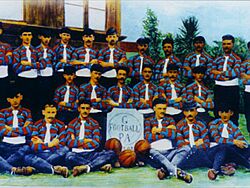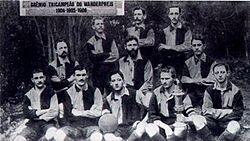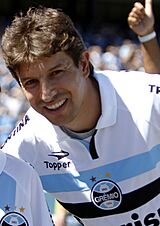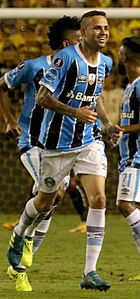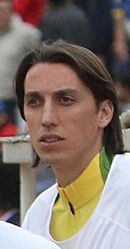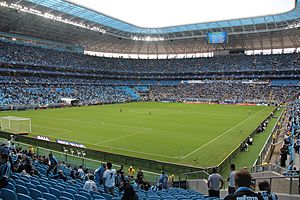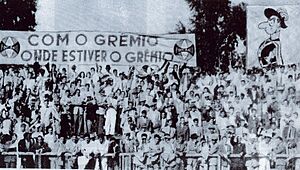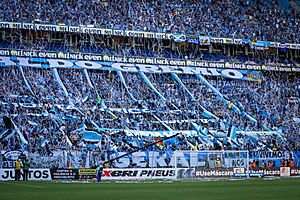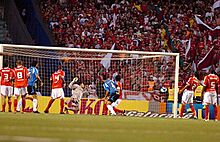Grêmio FBPA facts for kids
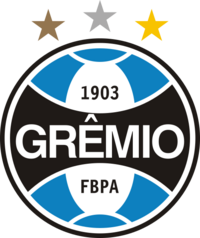 |
||||
| Full name | Grêmio Foot-Ball Porto Alegrense | |||
|---|---|---|---|---|
| Nickname(s) | Imortal Tricolor (Immortal Tricolor) Tricolor dos Pampas (Tricolor of the Pampas) Clube de Todos (Club of All) |
|||
| Founded | 15 September 1903 | |||
| Ground | Arena do Grêmio | |||
| Capacity | 55,662 | |||
| President | Alberto Guerra | |||
| Head coach | Mano Menezes | |||
| League | Campeonato Brasileiro Série A Campeonato Gaúcho |
|||
| 2024 2024 |
Série A, 14th of 20 Gauchão, 1st of 12 (champions) |
|||
|
||||
Grêmio Foot-Ball Porto Alegrense, usually called Grêmio, is a professional football club from Porto Alegre, Brazil. This team plays in the top Brazilian league, the Campeonato Brasileiro Série A, and also in their state league, the Campeonato Gaúcho. Grêmio was started on September 15, 1903, by Cândido Dias da Silva and 32 other people, many of whom were German immigrants.
Grêmio's home stadium is the Arena do Grêmio. They moved there in 2013. The stadium can hold over 55,000 fans. It is one of the most modern stadiums in South America. Before 2013, Grêmio played at Estádio Olímpico Monumental since 1954. Grêmio's uniform is a tricolor (blue, black, and white) striped shirt, black shorts, and white socks. This is why they are nicknamed "Tricolor."
Grêmio has won many important titles. In 1983, they won the Intercontinental Cup by beating Hamburger SV. They have also won the Copa Libertadores three times, which is a big South American championship. This makes them one of the most successful Brazilian clubs in this competition.
In 2017, Grêmio was ranked as the top club by the CBF. Forbes magazine also listed them as one of the most valuable football clubs in the Americas. Grêmio has won 43 Campeonato Gaúcho titles, 2 Campeonato Brasileiro Série A titles, and 5 Copa do Brasil titles. They have also won 1 Intercontinental Cup and 3 Copa Libertadores de América titles.
Grêmio has a very strong rivalry with Internacional. Their matches are called Grenais. This rivalry is known as one of the most intense in Brazil and worldwide.
Contents
Club History
How Grêmio Started
On September 7, 1903, Brazil's oldest football team, Sport Club Rio Grande, played a game in Porto Alegre. A businessman named Cândido Dias loved football. He went to watch the match. During the game, the ball went flat. Since he was the only one in Porto Alegre with a football, he lent his ball.
After the game, Cândido talked to local players about starting a new club. On September 15, 1903, 32 people, including Cândido, met at a restaurant. They founded "Grêmio Foot-Ball Porto Alegrense." Most of them were from the city's German community. Carlos Luiz Bohrer became the first president.
Grêmio's first match was on March 6, 1904, against Fuss Ball Porto Alegre. Grêmio won 1–0. The name of the player who scored the first goal is not known. The trophy Grêmio won that day, the Wanderpreis, is still in the club's museum. Within five months, the club opened its first home stadium, the Baixada.
On July 18, 1909, Grêmio beat Internacional 10–0 in Internacional's first game. Grêmio's goalkeeper even left the field to chat with fans during the match! This big win is still a source of pride for Grêmio fans. This game also started the famous rivalry between the two clubs.
Grêmio helped create the Porto Alegre football league in 1910. They won the league for the first time in 1911. On August 25, 1912, Grêmio beat Sport Clube Nacional 23–0. Sisson scored 14 goals, which is Grêmio's biggest win ever. In 1921, Grêmio won its first state championship. This was a year after the famous goalkeeper Eurico Lara joined the team.
Early Success and International Games
On July 7, 1911, Grêmio beat Uruguay's national team 2–1. In 1931, Grêmio was one of the first teams in Brazil to play night matches. They installed floodlights at Estádio Baixada. On May 19, 1935, Grêmio became the first team from Rio Grande do Sul to beat a team from São Paulo. They defeated Santos 3–2.
Grêmio was also the first club from outside Rio de Janeiro to play at the famous Maracanã Stadium. They beat Flamengo 3–1 in 1950. During this time, Grêmio started to become known internationally. In 1932, they played their first international match in Uruguay.
In 1949, Grêmio beat Uruguay's Nacional 3–1. The players received a hero's welcome when they returned to Porto Alegre. Between 1953 and 1954, Grêmio toured Mexico, Ecuador, and Colombia. This tour was called "the conquest of the Americas." On February 25, 1959, Grêmio beat Boca Juniors 4–1 in Buenos Aires. They were the first foreign team to beat Boca at their home stadium, La Bombonera.
In 1961, Grêmio went on its first European tour. They played 24 games in 11 countries. Grêmio fans, called Gremistas, were growing in number. In 1946, the club's motto appeared: "com o Grêmio onde o Grêmio estiver" ("with Grêmio wherever Grêmio may be"). This motto was later put into Grêmio's official anthem. The anthem was written by Lupicinio Rodrigues, a famous composer and Grêmio fan. It celebrates how Gremistas always support their team, no matter what.
In 1954, Grêmio opened the Olímpico Stadium. It was the biggest private stadium in Brazil at the time. In 1971, the Campeonato Brasileiro championship began. Grêmio's Néstor Scotta scored the first goal in this new league.
Winning Big: The 1983 Intercontinental Cup
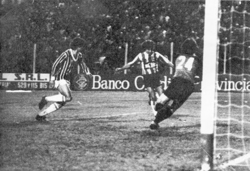
Grêmio's first big period of success in South American football began in the early 1980s. This was helped by their new stadium, the Olímpico Monumental.
Grêmio won its first Campeonato Brasileiro Série A title on May 3, 1981. They defeated São Paulo in the final. The winning goal was scored by striker Baltazar.
The year 1983 was very successful for Grêmio. First, they won the South American Copa Libertadores. One of their semi-final matches, a 3–3 draw against Estudiantes, became famous for being very intense. It was called the "Batalha de La Plata" ("Battle of La Plata"). In the finals, Grêmio beat the champions from Uruguay, Peñarol. They drew 1–1 in Montevideo and won 2–1 in Porto Alegre.
Also in 1983, Grêmio won the Intercontinental Cup. They beat Hamburger SV of Germany 2–1. Renato Portaluppi scored both goals. After winning the Intercontinental Cup, Grêmio also won the Los Angeles Cup.
In 1989, Grêmio won the first Copa do Brasil. This is a knockout cup for teams across Brazil. They beat Sport Recife in the final.
In 1991, Grêmio was relegated to the Brazilian Second Division. But they quickly returned to the top league in 1993. In 1994, Grêmio won its second Copa do Brasil. They defeated Ceará in the final.
Luiz Felipe Scolari and More Wins
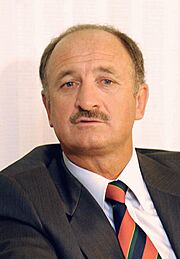
In 1995, under coach Luiz Felipe Scolari, Grêmio won the Copa Libertadores for the second time. They beat Atlético Nacional of Colombia. The tournament included tough matches against Palmeiras. Grêmio won one game 5–0 with three goals from Mário Jardel.
This win allowed Grêmio to play in the 1995 Intercontinental Cup. They played against a strong Ajax team. The game went to extra time and penalties. In early 1996, Grêmio won the Recopa Sudamericana, beating Independiente 4–1.
On December 15, 1996, Grêmio won its second Campeonato Brasileiro Série A title. They defeated Portuguesa in the final. Grêmio won the title because they had a better league finish.
In 1997, Grêmio won their third Copa do Brasil title. They beat Romário's Flamengo on away goals. Four years later, in 2001, Grêmio won their fourth Copa do Brasil. They defeated Corinthians in a memorable final game.
Tough Times and a Big Comeback
In 2004, Grêmio had a bad season and was relegated to the Second Division. This meant less money for the club. Grêmio fought hard to get back to the top league. On November 26, 2005, they played a very dramatic match against Náutico. This game is known as "The Battle of the Aflitos."
In that game, Grêmio had four players sent off and two penalties given against them. Goalkeeper Galatto saved the second penalty. Just seconds later, 17-year-old Anderson scored the winning goal for Grêmio. This goal secured the Série B championship and promotion back to Série A.
On April 9, 2006, Grêmio won the state championship against their rivals Internacional. This stopped Internacional from winning five titles in a row. In 2007, Grêmio won the Campeonato Gaúcho again.
Also in 2007, Grêmio reached the final of the 2007 Copa Libertadores. The team earned the nickname "Imortal Tricolor" for their strong home performances. Fans showed huge support, even queuing for days to buy tickets for the final. However, Boca Juniors won the title.
Renato Portaluppi and the 2017 Libertadores
In 2016, former Grêmio player Roger Machado became manager. He led the team to qualify for the 2016 Copa Libertadores. He also oversaw a big 5–0 win against rivals Internacional. Later that year, Roger resigned. Renato Portaluppi took over as coach. Under his leadership, Grêmio won the 2016 Copa do Brasil. This made them the Brazilian club with the most titles in this tournament (5). Fans started calling Grêmio the "Rei de Copas" (King of Cups).
In 2017, Grêmio won their third Libertadores title. They defeated Club Atlético Lanús in the final. Luan was named the best player of the tournament. Goalkeeper Marcelo Grohe made an amazing save in the semi-final. Grêmio became the third Brazilian club to win three Copa Libertadores titles.
The club then represented South America at the 2017 FIFA Club World Cup in the United Arab Emirates. Grêmio beat Pachuca 1–0 in the semi-final. They lost 0–1 to Real Madrid in the final.
Recent Seasons and Return to Série A
In 2018, Grêmio finished 4th in the Campeonato Brasileiro Série A. This earned them a spot in the 2019 Copa Libertadores. They were knocked out in the semi-final of the 2018 tournament by River Plate.
In 2020, Grêmio played their rivals Internacional in the Copa Libertadores for the first time. The first game ended in a fight between players, and eight players were sent off. The match ended in a tie.
The 2020 season saw a drop in the team's performance. They won the Campeonato Gaúcho but finished 6th in the Brasileirão. This meant they had to play in the qualifying stages for the Libertadores. They failed to qualify after losing to Independiente del Valle. This led to the resignation of Renato Portaluppi, who had been with the club for almost five years.
In 2021, Grêmio was named the best club in South America for the decade (2011-2020) by the International Federation of Football History & Statistics (IFFHS).
After a series of challenges, Grêmio finished the 2021 Campeonato Brasileiro in the relegation zone. They were relegated to the Campeonato Brasileiro Série B for the third time.
In 2022, Roger Machado led the team to win their fifth Gauchão title in a row. Later, Renato Portaluppi returned as coach. The team's performance in the Campeonato Brasileiro Série B was good enough to get them back into Série A for 2023.

In December 2022, Grêmio announced that famous player Luis Suárez would join the club for two years. Suárez made his debut on January 17, 2023, scoring three goals in a 4–1 win. With Suárez, Grêmio won the 2023 Campeonato Gaúcho, their sixth in a row. Suárez later shortened his contract to one year due to knee injuries. With him, Grêmio finished 2nd in the 2023 Campeonato Brasileiro Série A, qualifying for the 2024 Copa Libertadores.
In 2024, Grêmio won the 2024 Campeonato Gaúcho for the seventh time in a row, with Renato Gaúcho as manager.
Club Symbols
Stars
Grêmio's club badge has different colored stars. The gold star means they won the World Club Championship. The silver stars represent their three South American competition wins. The bronze star stands for their national competition victories.
There is also a gold star on Grêmio's flag. This star honors Everaldo, who was the only Grêmio player on Brazil's 1970 World Cup winning team.
Flag
The first club flag was shown when the Baixada stadium opened. It had horizontal blue, black, and white stripes. The Brazilian Flag inspired the club's flag from 1918 to 1944.
Mascot
Grêmio's mascot is the Musketeer. A cartoonist named Pompeo created the musketeer in 1946. He was inspired by Alexandre Dumas's book The Three Musketeers. The musketeer represents the team's unity, bravery, and determination. A banner with the slogan "With Grêmio wherever Grêmio is" appeared that same year.
On December 1, 2023, Grêmio introduced a new mascot, "Black Arrow." This mascot is inspired by club legend Tarciso Flecha Negra. Black Arrow appears alongside the Musketeer, not replacing him.
Anthem
Grêmio's anthem is very famous in Brazilian football. It was composed by Lupicínio Rodrigues, a well-known composer. The anthem has famous lines like: Até a pé nós iremos / para o que der e vier / mas o certo é que nós estaremos / com o Grêmio onde o Grêmio estiver (Even on foot we will go / against all obstacles / but we sure will be / with Grêmio wherever Grêmio may be). Grêmio fans are proud that their team has never played without supporters, anywhere in the world.
Eurico Lara, a goalkeeper from the 1920s and 1930s, is mentioned in the anthem. He is called the immortal idol.
Team Kit
Grêmio's team colors are blue, black, and white. This is a unique color combination for football shirts. The first Grêmio kit was inspired by the English club Exeter City. It included a black cap, striped shirt in blue and havana (a brown color), a white tie, white shorts, and black socks.
Later, the uniform changed to blue and black because havana fabric was hard to find. Soon after, white vertical stripes were added. This created the striped pattern used today. Because of these three colors, Grêmio is often called the "Tricolor."
The club's official colors are:
- Home colors: vertical stripes of light blue and black, with white details.
- Away colors: white with blue and black details.
- Alternative colors: dark blue or blue with white details.
Stadium
Grêmio's first stadium was the Estádio da Baixada. It was built in 1904 in Porto Alegre. Grêmio played there until 1954.
The second stadium was the Estádio Olímpico Monumental. It opened on September 19, 1954. At the time, it was the largest private stadium in Brazil. The first game at Olímpico was between Grêmio and Nacional from Uruguay. Grêmio won 2–0.
In 1980, a second level was added to the Olímpico, and it was renamed Olímpico Monumental. The stadium's record attendance was 98,421 people in 1981.
By the 2000s, the Olímpico stadium was getting old and expensive to maintain. The club decided to build a new stadium. Construction for the new stadium began in September 2010.
In 2012, Grêmio moved into their new home, Arena do Grêmio. This large stadium in Porto Alegre can hold 55,225 people. It is one of the most modern stadiums in South America. The first match at Arena was a friendly game against Hamburger SV on December 8, 2012.
Training Centre
Grêmio's first training area was next to the Estádio Olímpico Monumental. In 2000, the club built its first training center, the CT Hélio Dourado. It was a bit far away, so it was mainly used for the club's youth academy.
In 2014, Grêmio finished building a new training center, the CT Luiz Carvalho. It is located right next to the Arena do Grêmio in Porto Alegre. It has beautiful views of the city and the Guaíba River.
Supporters
Grêmio fans are called "gremistas" or "tricolores." In the past, many Grêmio fans were of German descent. Today, the fan base is very diverse. Grêmio and Internacional divide the population of Rio Grande do Sul. Grêmio is also popular in other parts of Brazil.
A 2022 study showed that Grêmio has some of the most "loyal" fans in Brazil. About 90.6% of Grêmio fans said they only support Grêmio. In 2023, Grêmio had over 100,000 sócios (club members).
Geral do Grêmio
The largest group of Grêmio supporters is Geral do Grêmio. This group started in 2001. They were inspired by fan groups in Argentina and Uruguay. They watch games from the "Geral" section of the stadium, where tickets are cheaper.
A special tradition of this group is the "avalanche." When Grêmio scores a goal, fans run down the stands towards the fence to celebrate. The Arena do Grêmio was built with a special section for this group. However, safety barriers were added in 2013 to prevent fans from falling.
The Geral do Grêmio group does not charge a monthly fee. They do not have uniforms or control who joins. They bring musical instruments to games and sing chants throughout the match. They also use flares and smoke bombs to cheer on the team.
Other Supporters
Other Grêmio fan groups include Torcida Jovem do Grêmio, Rasta do Grêmio, Super Raça Gremista, Garra Tricolor, Máfia Tricolor, and Velha Escola. There are also groups just for female supporters.
An important historical group is Coligay, Brazil's first LGBT supporter group. It was founded in 1977. The group faced challenges but was generally accepted by Grêmio fans. They were even seen as a "lucky charm" because their founding happened during a time of many Grêmio victories.
Rivalries
Grenal
Over the years, Grêmio and Internacional developed a strong rivalry. Matches between these two clubs are called Grenal. This rivalry divides the state of Rio Grande do Sul and the city of Porto Alegre. It is one of the most intense football rivalries in the world.
The first Grenal match was in 1909. Grêmio won 10–0. Grêmio led the rivalry statistics for many years. However, Internacional took the lead in 1945 and has held it since.
In 1935, Grêmio's goalkeeper, Eurico Lara, faced a penalty kick. His brother warned him not to overexert himself due to his health. But Lara insisted on playing. He saved the penalty but then collapsed. He was substituted and sadly passed away two months later due to the fatigue from that game. Lara is remembered in the club anthem.
Gre-Ju
Gre-Ju is another rivalry in Rio Grande do Sul, between Grêmio and Juventude from Caxias do Sul. For most of its history, Juventude was a weaker team. But the rivalry became more intense in the 1990s as Juventude grew stronger.
Players
First Team Squad
|
|
Reserves Squad
|
|
Players on Loan
|
|
Club Officials
- Board Members
- President: Alberto Guerra
- Vice-president of Football: Alexandre Rossato
- Head Coach: Mano Menezes
- Technical Coordinator: Luiz Felipe Scolari
Honours
Official Tournaments
| Worldwide | ||
|---|---|---|
| Competitions | Titles | Seasons |
| Intercontinental Cup | 1 | 1983 |
| Continental | ||
| Competitions | Titles | Seasons |
| Copa Libertadores | 3 | 1983, 1995, 2017 |
| Recopa Sudamericana | 2 | 1996, 2018 |
| National | ||
| Competitions | Titles | Seasons |
| Campeonato Brasileiro Série A | 2 | 1981, 1996 |
| Copa do Brasil | 5 | 1989, 1994, 1997, 2001, 2016 |
| Supercopa do Brasil | 1 | 1990 |
| Campeonato Brasileiro Série B | 1 | 2005 |
| Regional | ||
| Competitions | Titles | Seasons |
| Copa Sul | 1 | 1999 |
| Campeonato Sul-Brasileiro | 1 | 1962 |
| State | ||
| Competitions | Titles | Seasons |
| Campeonato Gaúcho | 43 | 1921, 1922, 1926, 1931, 1932, 1946, 1949, 1956, 1957, 1958, 1959, 1960, 1962, 1963, 1964, 1965, 1966, 1967, 1968, 1977, 1979, 1980, 1985, 1986, 1987, 1988, 1989, 1990, 1993, 1995, 1996, 1999, 2001, 2006, 2007, 2010, 2018, 2019, 2020, 2021, 2022, 2023, 2024 |
| Copa FGF | 1 | 2006 |
| Recopa Gaúcha | 5 | 2019, 2021, 2022, 2023, 2025 |
- record
Runners-up
- FIFA Club World Cup (1): 2017
- Intercontinental Cup (1): 1995
- Copa Libertadores (2): 1984, 2007
- Campeonato Brasileiro Série A (4): 1982, 2008, 2013, 2023
- Copa do Brasil (4): 1991, 1993, 1995, 2020
- Campeonato Brasileiro Série B (1): 2022
- Campeonato Gaúcho (28): 1919, 1920, 1925, 1930, 1933, 1935, 1961, 1969, 1970, 1971, 1972, 1973, 1974, 1975, 1976, 1978, 1981, 1982, 1984, 1991, 1992, 1997, 2000, 2009, 2011, 2014, 2015, 2025
- Recopa Gaúcha (2): 2020, 2024
Youth Team Honours
- Campeonato Brasileiro Sub-23 (1): 2021
- Campeonato Brasileiro Sub-20 (2): 2008, 2009
- Taça Belo Horizonte de Juniores (2): 2008, 2012
- Copa Rio Grande do Sul de Futebol Sub-20 (3): 2008, 2009, 2019
- Copa Santiago de Futebol Juvenil (7): 1995, 1996, 1997, 1998, 2000, 2008, 2019
Campeonato Brasileiro Record
| Year | Position | Year | Position | Year | Position | Year | Position | Year | Position | Year | Position |
|---|---|---|---|---|---|---|---|---|---|---|---|
| 1971 | 6th | 1981 | 1st | 1991 | 19th |
2001 | 5th | 2011 | 12th | 2021 | 17th |
| 1972 | 10th | 1982 | 2nd | 1992 | Série B |
2002 | 3rd | 2012 | 3rd | 2022 | Série B |
| 1973 | 5th | 1983 | 14th | 1993 | 11th | 2003 | 20th | 2013 | 2nd | 2023 | 2nd |
| 1974 | 5th | 1984 | 3rd | 1994 | 11th | 2004 | 24th |
2014 | 7th | 2024 | 14th |
| 1975 | 14th | 1985 | 18th | 1995 | 15th | 2005 | Série B |
2015 | 3rd | ||
| 1976 | 6th | 1986 | 16th | 1996 | 1st | 2006 | 3rd | 2016 | 9th | ||
| 1977 | 13th | 1987 | 5th | 1997 | 14th | 2007 | 6th | 2017 | 4th | ||
| 1978 | 6th | 1988 | 4th | 1998 | 8th | 2008 | 2nd | 2018 | 4th | ||
| 1979 | 22nd | 1989 | 11th | 1999 | 18th | 2009 | 8th | 2019 | 4th | ||
| 1980 | 6th | 1990 | 3rd | 2000 | 4th | 2010 | 4th | 2020 | 6th |
See also
 In Spanish: Grêmio Foot-Ball Porto Alegrense para niños
In Spanish: Grêmio Foot-Ball Porto Alegrense para niños
- Grêmio FBPA (women)
- Grêmio FBPA (youth)
- List of world champion football clubs


